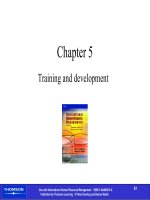Human resource management mondy 13th edition chapter 08
Bạn đang xem bản rút gọn của tài liệu. Xem và tải ngay bản đầy đủ của tài liệu tại đây (402.12 KB, 65 trang )
Human Resource Management
13th Edition
Chapter 8
Performance Management
and Appraisal
Copyright © [2014] Pearson Education
8-1
Learning Objectives
• Describe employee engagement, define performance
management, and describe the importance of performance
management.
• Define performance appraisal and identify the uses of
performance appraisal.
• Discuss the performance appraisal environmental factors,
describe the performance appraisal process, and discuss
whether or not a case can be made for getting rid of
performance appraisals.
• Identify the various performance criteria (standards) that can
be established.
• Identify who may be responsible for performance appraisal
and explain the performance period.
Copyright © [2014] Pearson Education
8-2
Learning Objectives (Cont.)
• Identify the various performance appraisal methods.
• List the problems that have been associated with
performance appraisal.
• Explain the characteristics of an effective appraisal
system.
• Describe the legal implications of performance appraisal.
• Explain how the appraisal interview should be conducted
and discuss how performance appraisal is affected by a
country’s culture.
Copyright © [2014] Pearson Education
8-3
HRM in Action: Employee Engagement
for a Committed Workforce
• Level of commitment workers make to
their employer
• Seen in their willingness to stay at the firm
and to go beyond call of duty
• Found in employees’ minds, hearts, and
hands
Copyright © [2014] Pearson Education
8-4
Performance Management (PM)
• Goal-oriented process ensuring processes
are in place to maximize productivity at
employee, team and organizational levels
• Close relationship between incentives and
performance.
• Dynamic, ongoing, continuous process
• Each part of the system is integrated and
linked for continuous organizational
effectiveness
Copyright © [2014] Pearson Education
8-5
Performance Appraisal Defined
• Formal system of review and
evaluation of individual or team task
performance
• Often negative, disliked activity that
seems to elude mastery
Copyright © [2014] Pearson Education
8-6
Uses of Performance Appraisal
•
•
•
•
•
•
•
Human resource planning
Recruitment and Selection
Training and development
Career planning and development
Compensation programs
Internal Employee Relations
Assessment of Employee Potential
Copyright © [2014] Pearson Education
8-7
Performance Appraisal
Environmental Factors
• External:
– Legislation requiring nondiscriminatory
appraisal systems
– Labor unions
• Factors within internal environment, such
as corporate culture
Copyright © [2014] Pearson Education
8-8
Trends & Innovations: Can a Case Be Made
for Getting Rid of Traditional Performance
Appraisal?
• Managers do not like administering
performance appraisal and employees do
not like receiving them
• Failures lies in lack of ownership by line
managers and employees
• At times developed for wrong reasons
• May be a better way
Copyright © [2014] Pearson Education
8-9
Performance Appraisal Process
External Environment
Internal Environment
Identify Specific
Performance Appraisal
Goals
Establish Performance
Criteria (Standards) and
Communicate Them To
Employees
Examine Work Performed
Appraise the Results
Discuss Appraisal with
Employee
Copyright © [2014] Pearson Education
8-10
Establish Performance Criteria
(Standards)
•
•
•
•
•
Traits
Behaviors
Competencies
Goal achievement
Improvement potential
Copyright © [2014] Pearson Education
8-11
Traits
• Employee traits such as attitude,
appearance, and initiative are basis for
some evaluations
• May be unrelated to job performance or be
difficult to define
• Certain traits may relate to job
performance
Copyright © [2014] Pearson Education
8-12
Caution on Traits: Wade v. Mississippi
Cooperative Extension Service
In performance appraisal system, general characteristics
such as “leadership, public acceptance, attitude toward
people, appearance and grooming, personal conduct,
outlook on life, ethical habits, resourcefulness, capacity for
growth, mental alertness, loyalty to organization are
susceptible to partiality and to the personal taste, whim, or
fancy of the evaluator as well as patently subjective in form
and obviously susceptible to completely subjective
treatment by those conducting the appraisals”
Copyright © [2014] Pearson Education
8-13
Behaviors
• Organizations may evaluate employee’s
task-related behavior or competencies
• Examples are leadership style, developing
others, teamwork and cooperation, or
customer service orientation
• If certain behaviors result in desired
outcomes, there is merit in using them in
evaluation process
Copyright © [2014] Pearson Education
8-14
Competencies
• Broad range of knowledge, skills, traits, and
behaviors
• May be technical in nature, business oriented,
or related to interpersonal skills
• Should be those that are closely associated with
job success
Copyright © [2014] Pearson Education
8-15
Goal Achievement
• Use if organizations consider ends more
important than means
• Should be within control of individual or
team
• Should be those results that lead to firm’s
success
Copyright © [2014] Pearson Education
8-16
Improvement Potential
• Many criteria used focus on past
• Cannot change past
• Should emphasize future
Copyright © [2014] Pearson Education
8-17
Responsibility for Appraisal
• Immediate supervisor
• Subordinates
• Peers and team members
• Self-appraisal
• Customer appraisal
Copyright © [2014] Pearson Education
8-18
Immediate Supervisor
• Traditionally most common choice
• Usually in excellent position to observe
employee’s job performance
• Has responsibility for managing particular
unit
Copyright © [2014] Pearson Education
8-19
Subordinates
• Our culture has viewed evaluation by
subordinates negatively.
• Some firms find that evaluation of
managers by subordinates is both
feasible and needed.
• Issues:
– Could be seen as a popularity contest
– Possible reprisal against employees
Copyright © [2014] Pearson Education
8-20
Peers and Team Members
• Work closely with evaluated employee and
probably have undistorted perspective on
typical performance
• Problems include reluctance of some people
who work closely together, especially on
teams, to criticize each other
Copyright © [2014] Pearson Education
8-21
Self-Appraisal
• If employees understand their objectives
and the criteria used for evaluation, they
are in a good position to appraise own
performance
• Employee development is selfdevelopment
• Self-appraisal may make employees more
highly motivated
Copyright © [2014] Pearson Education
8-22
Customer Appraisal
• Customer behavior determines firm’s degree
of success
• Demonstrates commitment to customer
• Holds employees accountable
• Fosters change
Copyright © [2014] Pearson Education
8-23
Performance Appraisal for
Telecommuters
• Well-defined understanding of job roles and
performance measures
• Have objective measurements that apply to all
employees
• Do not to vary the performance standards and
metrics for virtual workers from those of office
workers
Copyright © [2014] Pearson Education
8-24
The Appraisal Period
• Prepared at specific intervals
• Usually annually or semiannually
• Period may begin with employee’s
date of hire
• All employees may be evaluated at
same time
Copyright © [2014] Pearson Education
8-25









